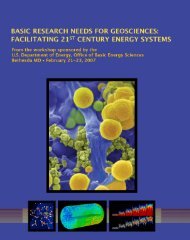Cyber Physical Systems â Situation Analysis - Energetics Meetings ...
Cyber Physical Systems â Situation Analysis - Energetics Meetings ...
Cyber Physical Systems â Situation Analysis - Energetics Meetings ...
- No tags were found...
You also want an ePaper? Increase the reach of your titles
YUMPU automatically turns print PDFs into web optimized ePapers that Google loves.
<strong>Cyber</strong> <strong>Physical</strong> <strong>Systems</strong> – <strong>Situation</strong> <strong>Analysis</strong>DRAFT – March 9, 2012sources of power generation. Incorporating power generated from distributed resources into the gridrequires new controls as well as complex balancing schemes. 120 For example, power generated from windis growing rapidly, yet it supplies an irregular stream of electricity. This type of source, along with otherdistributed sources, causes an additional stress on the current grid. 121 Energy storage technologies arecurrently not effective enough to support a higher penetration of renewable sources and there is only anill-defined hierarchy for integrating the sources into the grid. 122 Coordination of and interaction betweenvarying distributed resources will pose many new challenges. 123One of the challenges of applying CPS engineering and technology to the electric grid and other utilitiesis integrating these technologies into the existing infrastructure. Improvements and changes are beingapplied to the existing power grid system, which must transition into the smart grid of the future. 124 Therewill need to be changes in how the system is managed as power generation comes from more distributedthat need to be continually integrated into the existing infrastructure. Unforeseen complications andchallenges will arise as these distributed sources are connected to the grid on the regional and nationallevel. 125 Generation, storage, and distribution will have to remain dependent and stable even as sensingand actuation technologies are added to sections of the existing grid. 126 Automation and connectivityapplications in water-sector systems provide obvious improvements, but they are added to olderinfrastructure. This increased complexity of the system poses technical challenges and effects that mustbe considered as the system is operated in ways that were not intended when the infrastructure wasoriginally built. 127As technologies and systems are incorporated as part of the modernization of the grid, security remains aparamount concern in terms of lowering the vulnerability of the smart grid and water sector systems. 128Any disruptions to these sectors affect other sectors, making their secure operation a necessity. Theenergy and electric sectors are networked and complex, with increasing interactions between generation,transmission, and distribution processes, resulting in numerous access points. Control systems shouldhave integrated protection, detection, and response mechanisms to be able to survive natural disasters,human error, and cyber attack without loss of function. 129 Privacy of various stakeholder data will need tobe protected as the grid becomes more interconnected. 130Increased connectivity within the system allows for better interoperability and communication, yetsecurity risks increase as more entities are provided access. Although there are many benefits to placingsmart meters in residences, this provides another risk for cyber attack. These and other components andsubsystems in the smart grid should be securely integrated using security mechanisms, authenticationtechniques and protocols, and timely and secure communication and control networks. Increasedcomplexity, integration, and automation in the water sector allow for the possibility of security breachesor cyber attacks. 131120 Adam, Nabil. DHS. Workshop on Future Directions in <strong>Cyber</strong>-<strong>Physical</strong> <strong>Systems</strong> Security. 2010.121 Rajkumar, Ragunathan et al. <strong>Cyber</strong>-<strong>Physical</strong> <strong>Systems</strong>: The Next Computing Revolution. 2010.122 Adam, Nabil. DHS. Workshop on Future Directions in <strong>Cyber</strong>-<strong>Physical</strong> <strong>Systems</strong> Security. 2010.123 Rajkumar, Ragunathan et al. <strong>Cyber</strong>-<strong>Physical</strong> <strong>Systems</strong>: The Next Computing Revolution. 2010.124 Rajkumar, Ragunathan et al. <strong>Cyber</strong>-<strong>Physical</strong> <strong>Systems</strong>: The Next Computing Revolution. 2010.125 NSF. Report: <strong>Cyber</strong>-<strong>Physical</strong> <strong>Systems</strong> Summit. 2008.126 NSF. Report: <strong>Cyber</strong>-<strong>Physical</strong> <strong>Systems</strong> Summit. 2008.127 Adam, Nabil. DHS. Workshop on Future Directions in <strong>Cyber</strong>-<strong>Physical</strong> <strong>Systems</strong> Security. 2010.128 U.S. Government Accountability Office (GAO). Electricity and Modernization. 2011.129 Adam, Nabil. DHS. Workshop on Future Directions in <strong>Cyber</strong>-<strong>Physical</strong> <strong>Systems</strong> Security. 2010.130 EPRI. Report to NIST on the Smart Grid Interoperability Standards Roadmap. 2009.131 Adam, Nabil. DHS. Workshop on Future Directions in <strong>Cyber</strong>-<strong>Physical</strong> <strong>Systems</strong> Security. 2010.22
















